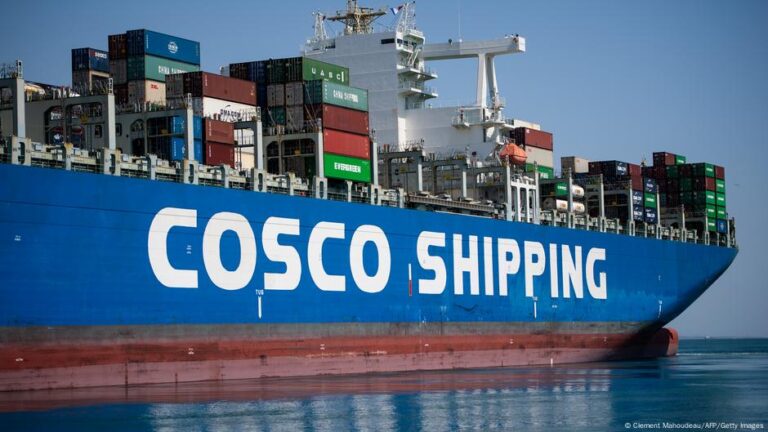“Derisk, diversify, and redirect trade” — a mantra once aimed at China’s expanding grip on global trade — is now being applied to the United States. President Donald Trump’s sweeping tariffs, currently totalling a staggering 145% on Chinese-made goods, have sent shockwaves through financial markets from Sydney to Sao Paolo.
Capital Economics warned late Thursday that unless the tariffs are rolled back, China’s exports to the US would plummet by more than half in the coming years, cutting Chinese economic growth by up to 1.5%. Many Chinese goods are made specifically for the American market, so economists worry that China will struggle to redirect those products to domestic consumers.
Beijing is, instead, rethinking its export strategy to prioritize other global trade partners to help soften the blow of diminishing exports to the US. Earlier this week, Chinese President Xi Jinping pledged to deepen “all-round cooperation” with China’s neighbors.
Diana Choyleva, founder and chief economist at Enodo Economics, a London-based research house focusing on China, believes Beijing will look to boost exports with regional neighbors, some of whom it has historically had strained relations.
China tries to mend ties with old foes
“The recent revival of Beijing’s economic dialogues with Japan — their first in six years — and South Korea suggests regional powers are reassessing relationships in response to American uncertainty,” Choyleva told DW. “While Seoul denied Chinese state media claims of a ‘joint response’ to tariffs, the mere renewal of trilateral economic cooperation after years of strained relations signals a strategic pivot.”
Chinese media said Friday that Xi would embark on a three-nation Southeast Asia tour next week to consolidate trade ties with Vietnam, Malaysia and Cambodia.
Over the past two decades, China and Southeast Asia have significantly deepened their trade link. In 2023, the total trade volume between China and ASEAN nations reached approximately $872 billion (€794 billion), according to Chinese government data. This figure is set to grow further now that Chinese firms are effectively frozen out of the US market.
“[Chinese manufacturers] will be looking for pockets of opportunity in Southeast Asia that in the past they may not spent the time, effort and money researching because they had a lucrative American market that sucked in everything they produced,” Deborah Elms, Singapore-based head of trade policy at the Hinrich Foundation, told DW.
Europe also needs to diversify trade
Although paused for 90 days, the European Union faces a new 20% tariff on up to €380 billion ($416 billion) worth of exports to the US. Policymakers in Brussels are weighing a similar response to China’s. The EU says it plans to reach out to countries in the Indo-Pacific and Global South in a bid to counter US protectionism.
During a three-day visit to Vietnam this week, Spain’s Prime Minister Pedro Sanchez insisted that Europe explore new markets and said his government was “firmly committed” to opening up his country and Europe to more trade with Southeast Asia.
But Varg Folkman, a policy analyst at the European Policy Centre (EPC) warned that Europe will struggle to replace exports across the Atlantic with other markets as the US economy is both “larger and wealthier.”
Folkman noted a “great resistance” among EU members to new trade deals, singling out France’s wariness to opening up its agricultural sector to Brazil and Argentina during the EU’s trade deal with Mercosur, the South American regional bloc. The deal took 25 years to negotiate and has yet to be ratified.
“Trade deals are controversial,” he told DW. “It will potentially be very hard to implement new ones even with the urgency we see today.”
While the EU and China could seek to boost bilateral trade, economists and policymakers also fear Europe could struggle to deal with the double whammy of much higher US tariffs and fresh trade rivalry with China, the world’s second-largest economy.
Chinese oversupply threatens European rivals
In a commentary published Tuesday, the Center for Strategic and International Studies (CSIS), a Washington-based think tank, wrote that the US tariffs on China “may well end up generating a diversion of Chinese export goods to the European Union, which will put additional pressures on European producers and likely raise calls for a protectionist response from Brussels.”
The EU has long voiced concerns over large state subsidies handed to Chinese producers, allowing them to “dump” artificially cheap goods on European markets. These subsidies, along with cheap labor costs and huge economies of scale, have piled pressure on European competitors, leading to bankruptcies and significant job cuts.
Electric vehicles (EV) are the most recent examples. Thanks to government grants, tax breaks and cheap loans, Chinese EV brands like BYD, Nio, and XPeng are now aggressively entering the EU market, undercutting their domestic rivals.
Europe’s auto industry is now undergoing a major restructuring, threatening plant closures, the downsizing of other factories and the loss of tens of thousands of jobs, especially in Germany.
While Washington imposed a 100% tariff on Chinese-made EVs, effectively locking China’s carmakers out of the US market, the EU’s tariff differs by Chinese automaker. The maximum is 35.3%, and just 17% is applied to BYD.
Elms, from the Hinrich Foundation, thinks there could be an “initial burst” of low-priced goods from Asia to the rest of the world because producers are “sitting on a mountain of products.”
“But they’re not going to keep producing goods that don’t return a profit, so Chinese firms will quickly pivot to making other products. Otherwise, they’ll be out of business,” she said.
New early-warning system could prevent ‘dumping’
Jörg Wuttke, the former head of German industrial giant BASF in China, warned of a Chinese “overcapacity tsunami” heading for Europe. which he hopes will not trigger new trade barriers from the EU. He called for improved “communication and trust” between Brussels and Beijing to avoid fresh dumping of goods.
Volkman, an expert on European industrial policy, doubts the EU will accept further trade distortions without resistance, telling DW: “The European Commission has signaled it will keep a close watch on imports and take action if a surge from China, or anywhere else, forces it to.”
In 2023, the EU announced plans for an import surveillance task force to monitor sudden surges in imports that could threaten European industries. The early-warning system was created to help the bloc derisk from China amid geopolitical tensions and concerns about dumping.
However, there are concerns that other Asian exporters and the US could also offload excess goods in the EU at low prices. The task force could help Brussels respond much faster to threats from various sides, with anti-dumping investigations, tariffs and temporary curbs on imports.
Brussels would, however, face criticism for mirroring Trump’s protectionist policies, marking a departure from the EU’s longstanding support for free trade, further eroding World Trade Organization norms and risking an escalation of global trade tensions.
Edited by: Uwe Hessler
Editor’s note: This story was first published on April 10, 2025 and updated with the latest information on April 11.


